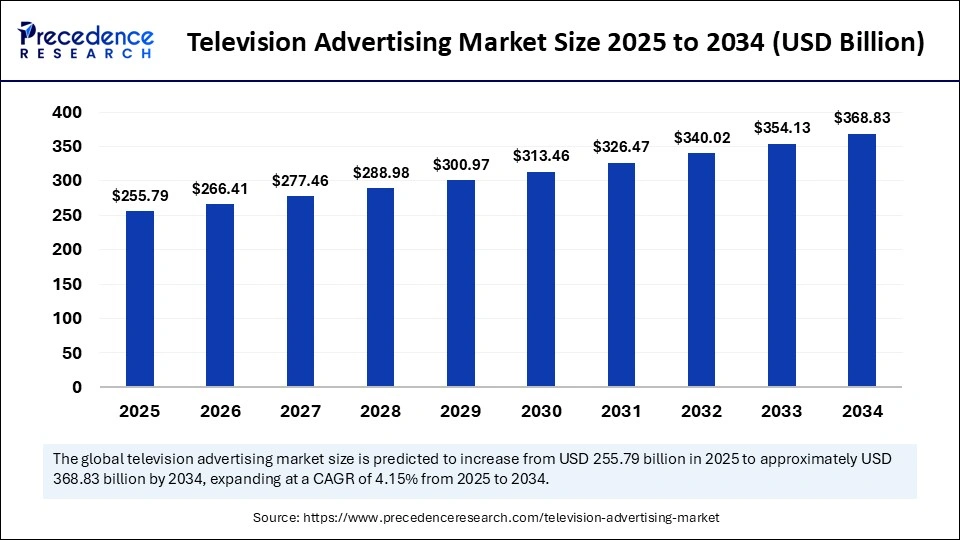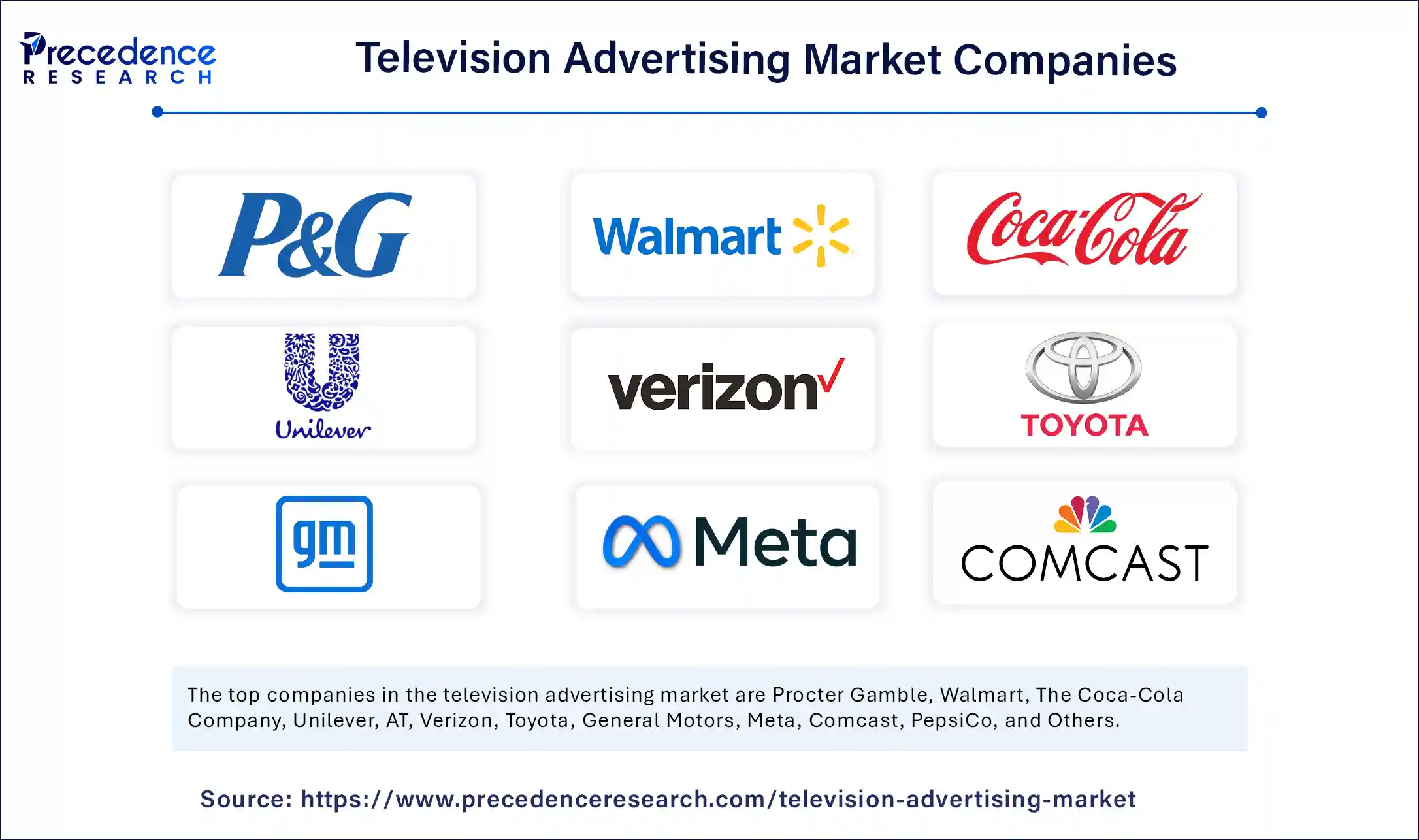
Television Advertising Market Key Highlights
- North America dominated the market with the largest share of 33% in 2024.
- Asia Pacific is expected to grow at the fastest CAGR in the upcoming period.
- By advertising format, the video advertising segment held the major market share of 56% in 2024.
- By advertising format, the interactive advertising segment is projected to grow at the fastest rate between 2025 and 2034.
- By target audience, the mass market segment dominated the market in 2024.
- By target audience, the niche market segment is likely to grow at a significant rate during the forecast period.
- By delivery platform, the broadcast television segment led the market in 2024.
- By delivery platform, the streaming services segment is projected to grow rapidly in the coming years.
Television Advertising Market Overview
The Television Advertising Market continues to play a pivotal role in the global advertising landscape despite the rise of digital platforms. Television advertising remains one of the most powerful tools for mass communication, offering unparalleled reach, especially in emerging markets and among specific demographics. The market encompasses various forms of ad content—ranging from traditional 15- to 60-second commercials to program sponsorships and product placements—broadcast across free-to-air, cable, satellite, and increasingly, connected TV (CTV) platforms.
While the global advertising ecosystem has shifted significantly toward digital and mobile formats, television still holds a major share due to its ability to deliver high-impact, emotion-driven storytelling on a broad scale. Major industries such as fast-moving consumer goods (FMCG), automotive, healthcare, and retail continue to rely on TV for brand awareness and recall. Events like the Super Bowl, Olympics, and national elections see television reach its zenith in ad revenues, demonstrating its enduring relevance. Additionally, the growing trend of “co-viewing” among families, combined with the integration of smart TVs and hybrid viewing habits, has allowed television advertising to remain resilient and adaptive in the digital age.
Television Advertising Market Growth Factors
The growth of the television advertising market is driven by a combination of technological, economic, and behavioral factors. One of the key growth contributors is the continued dominance of television in emerging economies, where internet penetration may still be limited and TV remains the primary source of news and entertainment. In countries like India, Brazil, and several African nations, the expanding middle class and increasing household access to televisions are directly correlated with increased ad spending.
Another factor is the evolution of content consumption behaviors, including time-shifted and on-demand viewing through digital TV platforms and streaming devices. This has opened new inventory opportunities for advertisers, especially through programmatic ad buying and dynamic ad insertion on CTVs. Moreover, the integration of second-screen experiences (e.g., viewers engaging with brands on smartphones while watching TV) is helping advertisers track engagement more precisely.
Seasonal events, sports tournaments, and reality TV shows remain strong anchors for advertising demand, particularly among live viewership segments. Political advertising, particularly in major election years, continues to inject billions of dollars into TV ad markets, further supporting revenue growth. Additionally, multi-platform advertising strategies, where brands coordinate television with digital, social media, and mobile campaigns, enhance the effectiveness of TV advertising and justify continued investments.
Impact of AI on the Television Advertising Market
Artificial Intelligence (AI) is rapidly transforming the television advertising ecosystem by enabling greater personalization, efficiency, and data-driven decision-making. AI is playing a critical role in audience segmentation and targeting, allowing advertisers to move beyond basic demographics to target specific behavioral segments and psychographic profiles based on viewership data. This is particularly powerful in the context of connected TV and streaming platforms, where granular data can be collected in real-time.
Programmatic advertising on TV—once limited to digital formats—is now being facilitated by AI, enabling real-time automated media buying and dynamic ad placements. AI algorithms assess viewership patterns and optimize ad slots based on factors like time of day, content genre, and viewer preferences, resulting in higher ad relevance and improved return on ad spend (ROAS).
AI is also revolutionizing creative optimization, helping advertisers tailor ad content for different audience segments. Through natural language processing (NLP), sentiment analysis, and image recognition, AI tools can suggest or even generate ad variations that better resonate with target audiences.
Furthermore, AI enhances measurement and attribution models by integrating cross-platform data to analyze the true impact of TV campaigns. Advanced analytics platforms use AI to connect TV ad exposure to consumer behavior, such as website visits or product purchases, thereby offering brands a clearer understanding of their campaign effectiveness.
Market Scope
| Report Coverage | Details |
| Market Size by 2034 | USD 368.83 Billion |
| Market Size in 2025 | USD 255.79 Billion |
| Market Size in 2024 | USD 245.6 Billion |
| Market Growth Rate from 2025 to 2034 | CAGR of 4.15% |
| Dominating Region | North America |
| Fastest Growing Region | Asia Pacific |
| Base Year | 2024 |
| Forecast Period | 2025 to 2034 |
| Segments Covered | Advertising Format, Target Audience, Delivery Platform, and Regions |
| Regions Covered | North America, Europe, Asia-Pacific, Latin America, and Middle East & Africa |
Market Drivers
-
High reach and emotional impact of television, which remains unmatched for brand storytelling and mass-market engagement.
-
Increased adoption of smart TVs and CTV platforms, expanding the scope of personalized and interactive advertising.
-
Rising content production and broadcast of live events, including sports, awards shows, and political debates, that attract high ad spend.
-
Stronghold of TV advertising in developing countries, where it continues to be the primary mass medium.
-
Brand safety concerns in digital environments, prompting advertisers to return to the more controlled ecosystem of TV advertising.
Opportunities
-
Growth of hybrid TV ecosystems, where linear broadcasting is integrated with digital and OTT platforms, enabling new monetization models.
-
Increased investment in AI and data analytics, enabling hyper-targeted and efficient ad campaigns.
-
Development of cross-platform advertising strategies, allowing advertisers to track consumers across TV, mobile, and desktop with unified attribution metrics.
-
Interactive and shoppable TV ads, allowing real-time viewer engagement and instant purchases, bridging the gap between branding and performance marketing.
-
Localized and vernacular advertising, particularly in culturally diverse regions, offers deep engagement and niche market penetration.
Challenges
-
Audience fragmentation, driven by the proliferation of streaming services, on-demand content, and ad-free subscriptions, has reduced the traditional reach of linear TV.
-
High production and media costs, particularly for prime-time slots or premium events, can limit access for smaller advertisers.
-
Measurement discrepancies and lack of unified standards, especially across linear and digital TV platforms, complicate ROI tracking and planning.
-
Ad skipping behavior, aided by DVRs and ad-blockers on streaming platforms, undermines the impact of traditional commercials.
-
Shift in advertiser budgets towards digital, influencer, and experiential marketing formats, particularly among brands targeting younger demographics.
Regional Outlook
North America remains one of the largest and most mature television advertising markets, led by the United States, which continues to attract significant ad spend for live sports, political campaigns, and prime-time programming. However, the region is also experiencing a strong pivot toward connected TV advertising and integrated cross-platform strategies.
Europe holds a significant market share, with strong public broadcasting systems and regulations that support both commercial and content quality. Countries like the UK, Germany, and France maintain robust TV advertising landscapes, although shifting consumption patterns are encouraging rapid digitization and hybrid content models.
Asia-Pacific is the fastest-growing region, driven by rising television penetration in countries like India, Indonesia, Vietnam, and the Philippines. Regional content preferences, cultural festivals, and growing consumer markets make TV a vital advertising channel. The convergence of mobile and TV, as well as regional language broadcasting, adds to its dynamism.
Latin America presents strong growth potential due to a large base of TV viewers, especially in markets like Brazil and Mexico. However, economic volatility and fluctuating ad budgets may constrain consistent growth. The Middle East and Africa, while still developing in terms of ad tech infrastructure, are seeing increasing ad investments, particularly around religious events, sports, and political programming.
Television Advertising Market Companies

- Procter Gamble
- Walmart
- The Coca-Cola Company
- Unilever
- AT
- Verizon
- Toyota
- General Motors
- Meta
- Comcast
- PepsiCo
- Target
- Amazon
- Ford Motor Company
Segments Covered in the Reports
By Advertising Format
- Display Advertising
- Video Advertising
- Interactive Advertising
By Target Audience
- Mass Market
- Niche Market
- Local Market
By Delivery Platform
- Broadcast Television
- Cable Television
- Satellite Television
- Streaming Services
By Region
- North America
- Europe
- Asia Pacific
- Middle East & Africa
- Latin America
Read Also: Electronic Nose Market
Get this report to explore global market size, share, CAGR, and trends, featuring detailed segmental analysis and an insightful competitive landscape overview @ https://www.precedenceresearch.com/sample/6083
You can place an order or ask any questions, please feel free to contact at sales@precedenceresearch.com|+1 804 441 9344